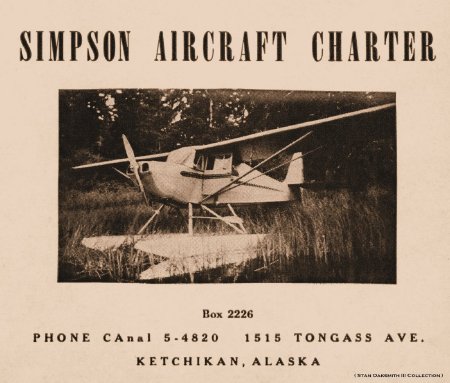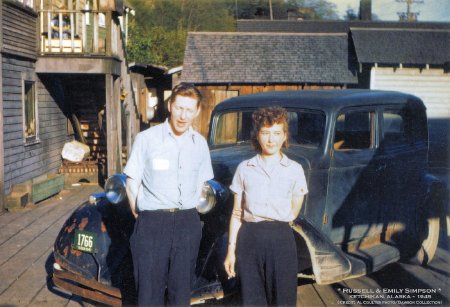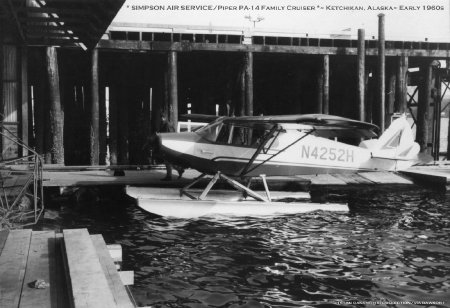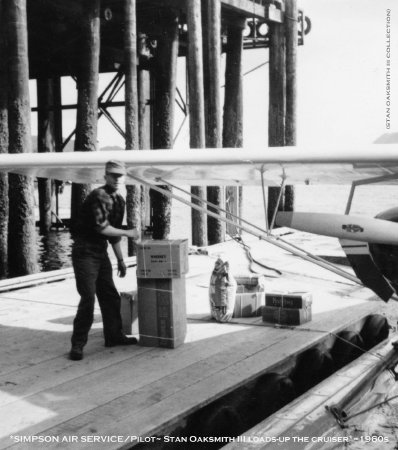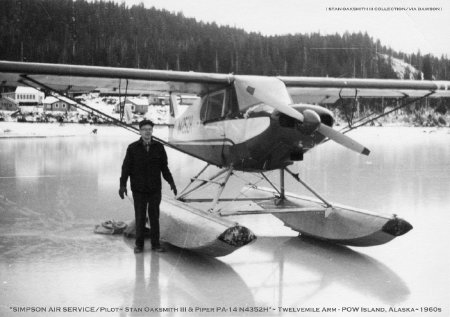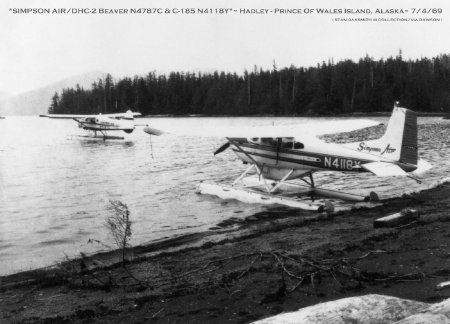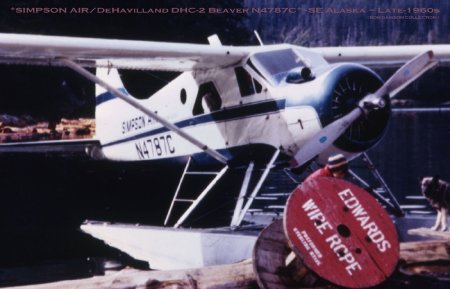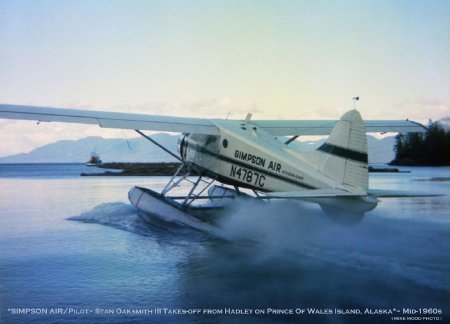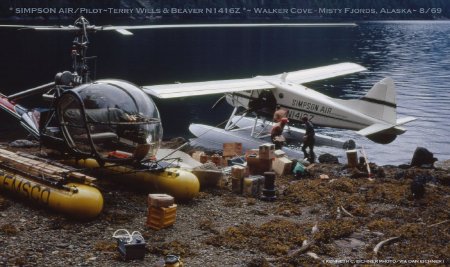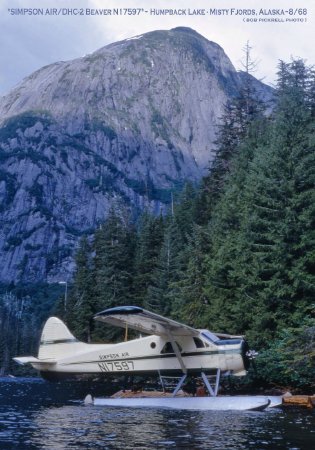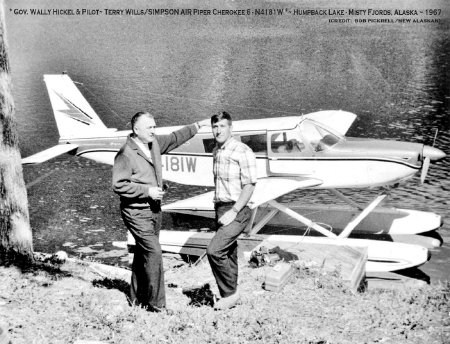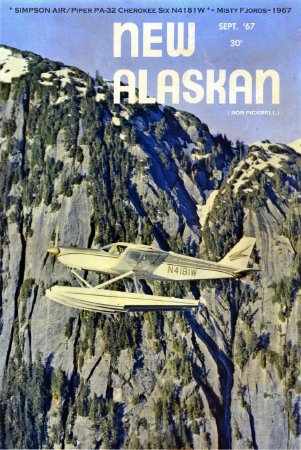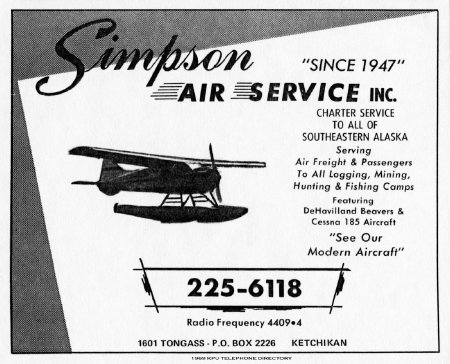Description:
Simpson Air Service, 1947-1970
Russell Simpson was born in Carnation, Washington and moved to Ketchikan in 1927 from Anacortes, Washington. Russ got his first airplane ride not long after his arrival in Southeast Alaska, and decided he wanted to learn to fly. He initially worked for several years as a foreman for the Ketchikan Packing Company cannery. After becoming a licensed pilot, he bought his first plane in 1945 from Ketchikan Air Service, a single-engine Aeronca S65A Chief floatplane (NC31774). Russ worked summers in the cannery from 1945-1951, and was flying sales and service manager for Northern Commercial Company in the winter. After getting his commercial license, he established Simpson Air Service in late 1946. In 1947, Russ flew in equipment for the construction of the Ketchikan Public Utilities (KPU) tunnel between Upper and Lower Silvis Lakes. Simpson Air Service's first hangar location was at 1715-A Tongass Avenue. The business became a fulltime air taxi charter business in 1958 with hangar and docks at 1517 Tongass Avenue, adjacent to competitor Webber Air Service.
Simpson Air Service first operated several different models of float equipped Piper aircraft that included Super Cruiser, Family Cruiser, and Pacer models. The company eventually upgraded with the addition of a Cessna 180 and 185 Skywagon. Russ initially did his own maintenance with help from several local mechanics, and hired Stan Oaksmith III as both pilot and mechanic. In 1962, George Towle became Simpson Air Service's primary maintenance chief and Dick Hamlin was hired to fly for the company as charter demand increased. Young pilot Terry Wills was added to the roster in early 1964. Wills learned to fly while working next door at Webber Air Service as a dockhand. Jack Cousins and Dave Metcalf were two other notable Simpson pilots.
Russ introduced many to pursuing a career in aviation. After Simpson's tragic loss on October 14, 1965, while piloting his Piper Pacer on Prince of Wales Island, Terry Wills assumed management and purchased company assets to become the new sole owner. Wills worked alongside Simpson's widow Emily, who had been instrumental in running the outfit in partnership with her husband. Terry Wills is credited for Simpson Air Service's precedent setting move as the first local commercial operator to introduce the stout and versatile Canadian designed DeHavilland DHC-2 Beaver bush plane into local service in 1967. Simpson Air Service added several Beavers to their growing fleet and it was immediately successful, sparking the type's popularity amongst their competitors. The first Beaver was (N167W; Construction No. 8). Three were bought from Wien Air Alaska in Fairbanks, which Wills and Oaksmith ferried down on wheels to be outfitted with Edo floats for local operations. A Piper Cherokee 6 on Edo floats was also tried, but didn't prove suitable in holding up under the routine daily rigors endured in commercial seaplane line duty.
Then tragedy struck on April 19, 1969, when eight people were killed with one survivor, when pilot Al White crashed taking off from a logging camp at Deweyville on the west coast of Prince of Wales Island, while flying the company's original Beaver (N167W). The accident proved to be a pivotal setback in the outfit's efforts to survive in Ketchikan's competitive air taxi scene. Simpson Air Service eventually evolved into Coast Air in 1971, when bought out by Bill Clapp of Seattle, who had been one of Simpson Air Service's pilots. Coast Air subsequently became Tyee Airlines in 1975.
Aircraft:
Aeronca S-65CA Chief, Piper PA-12 Super Cruiser, Piper PA-14 Family Cruiser, Piper PA-20 Pacer and Piper PA-32 Cherokee 6, Cessna 180 and 185 Skywagon, and DeHavilland DHC-2 Beaver.
Pilots:
Russell Simpson, Stan Oaksmith III, Terry Wills, Dick Hamlin, Jack Cousins, Dave Metcalf, Mike Woodson, Al White, Bill Clapp, and Gary Daubersmith, among others.
Mechanics:
Russ Simpson, Stan Oaksmith III, George Towle-DOM, and Gary Daubersmith, among others.
Simpson Air Service first operated several different models of float equipped Piper aircraft that included Super Cruiser, Family Cruiser, and Pacer models. The company eventually upgraded with the addition of a Cessna 180 and 185 Skywagon. Russ initially did his own maintenance with help from several local mechanics, and hired Stan Oaksmith III as both pilot and mechanic. In 1962, George Towle became Simpson Air Service's primary maintenance chief and Dick Hamlin was hired to fly for the company as charter demand increased. Young pilot Terry Wills was added to the roster in early 1964. Wills learned to fly while working next door at Webber Air Service as a dockhand. Jack Cousins and Dave Metcalf were two other notable Simpson pilots.
Russ introduced many to pursuing a career in aviation. After Simpson's tragic loss on October 14, 1965, while piloting his Piper Pacer on Prince of Wales Island, Terry Wills assumed management and purchased company assets to become the new sole owner. Wills worked alongside Simpson's widow Emily, who had been instrumental in running the outfit in partnership with her husband. Terry Wills is credited for Simpson Air Service's precedent setting move as the first local commercial operator to introduce the stout and versatile Canadian designed DeHavilland DHC-2 Beaver bush plane into local service in 1967. Simpson Air Service added several Beavers to their growing fleet and it was immediately successful, sparking the type's popularity amongst their competitors. The first Beaver was (N167W; Construction No. 8). Three were bought from Wien Air Alaska in Fairbanks, which Wills and Oaksmith ferried down on wheels to be outfitted with Edo floats for local operations. A Piper Cherokee 6 on Edo floats was also tried, but didn't prove suitable in holding up under the routine daily rigors endured in commercial seaplane line duty.
Then tragedy struck on April 19, 1969, when eight people were killed with one survivor, when pilot Al White crashed taking off from a logging camp at Deweyville on the west coast of Prince of Wales Island, while flying the company's original Beaver (N167W). The accident proved to be a pivotal setback in the outfit's efforts to survive in Ketchikan's competitive air taxi scene. Simpson Air Service eventually evolved into Coast Air in 1971, when bought out by Bill Clapp of Seattle, who had been one of Simpson Air Service's pilots. Coast Air subsequently became Tyee Airlines in 1975.
Aircraft:
Aeronca S-65CA Chief, Piper PA-12 Super Cruiser, Piper PA-14 Family Cruiser, Piper PA-20 Pacer and Piper PA-32 Cherokee 6, Cessna 180 and 185 Skywagon, and DeHavilland DHC-2 Beaver.
Pilots:
Russell Simpson, Stan Oaksmith III, Terry Wills, Dick Hamlin, Jack Cousins, Dave Metcalf, Mike Woodson, Al White, Bill Clapp, and Gary Daubersmith, among others.
Mechanics:
Russ Simpson, Stan Oaksmith III, George Towle-DOM, and Gary Daubersmith, among others.
Click to Enlarge

